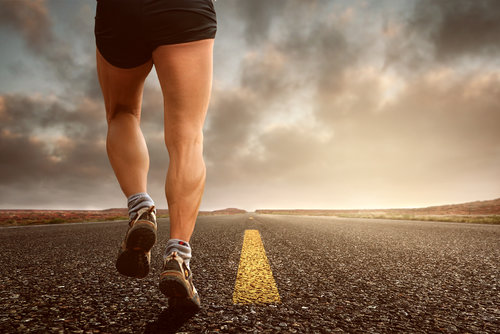Your summer body has begun construction, but after your first gym session you can barely move and the thought of conquering a flight of stairs is nauseating. You’re probably experiencing a case of DOMS. Here you’ll find the answers to all your delayed onset muscle soreness questions.
What is DOMS?
Delayed onset muscle soreness is the stiffness you feel between 24 and 48 hours after doing high-intensity physical exercise that your body is not accustomed to. It is distinctly prevalent if the exercise performed has an eccentric component. That is muscles are contracting while lengthening. For example, downhill or long-distance running, plyometric exercises and resistance work with a slow down component. Even particularly fit individuals will experience this after new activity.
The whole idea of resistance training is that you cause micro tears in the muscle fibres and therefore when they recover they are stronger, firmer and larger. Which personally I love because it means you can eat more! The soreness is a sign that you’re pushing your body to become better and therefore one step closer to your fitness goals.
DOMS is caused by micro tears in the muscle fibres and this micro trauma results in an inflammatory response in the muscle. As time passes, blood cells rush to the inflamed area to assist with the healing process, hence the I can’t move feeling, it will get worse before it gets better. Swelling, altered muscle firing and pain are the reason why muscle strength, motion and overall ability to function is impaired. After approximately 48 you’ll be beginning to feel more like the fitness warrior you are.

How do I treat it?
There are a few modalities to help put a dampen on the symptoms however it is likely that the pain won’t shift completely.
Massage
A form of self massage is foam rolling and this should be one of your essential components of your fitness routine. It assists in releasing trigger points and flushing waste products through your lymphatic system. Slowly roll each limb from all angles, it will be uncomfortable but then so is DOMS. I’d also recommend this immediately after a workout as it can assist in reducing the severity of DOMS.
Or if you’re super sore or really need to speed up recovery, you can visit a remedial massage therapist or physiotherapist. We have plenty here at Lifecare! Click the link to book in at Cottesloe or Claremont today!
Other
My personal favourite is a nice relaxing bath with a cup or two of Epsom salts. Epsom salts are rich in magnesium, a mineral that assists with muscle relaxation and widens your blood vessels that allows all the necessary blood cells to get to and from your sore muscles. You can buy Epsom salts at most pharmacies and supermarkets and they’re pretty cheap. It’s also a great excuse for a relaxing bath.
If you’re the brave sort, you may be able to withstand a cold bath. This helps to reduce the inflammation in the muscles thus the soreness. You’ll see this sort of stuff going on in change rooms post elite sporting games. Or you can even try contrast water therapy, alternate between hot and cold bath or shower.
You can also eat to help you recover, yay! A high protein meal with some slow release carbohydrate and rich in antioxidants is the way to go. Any excuse to bring on the food!
Prevention
There are a few options to prevent or at least reduce the severity of DOMS. One options is compression tights/socks. There are many ranges available from various sports shops. It is best to put them on after exercise and keep them on for 24 hours post.
Returning to exercise
You can workout through DOMs. The best kind of exercise is low impact cardio, like walking or swimming. I’d also recommend stretching or a yoga class.
I’d recommend waiting until your body is feeling more normal to fling yourself back to high intensity training. It is important to listen to your body in order to help prevent injuries. If you do want to do some resistance work, I’d recommend not putting your usual weight on the bar, your muscles won’t be firing as well and therefore you risk injury with a heavier weight.

